Vertebral Artery Occlusion: Nursing Care Plan and Discharge Planning
VerifiedAdded on 2023/01/04
|11
|2992
|95
Report
AI Summary
This report presents a comprehensive analysis of a case study involving a 56-year-old patient, Jason Bourne, diagnosed with vertebral artery occlusion. The assignment begins with an examination of the pathophysiology of the condition, correlating it with the patient's presenting symptoms of dizzines...
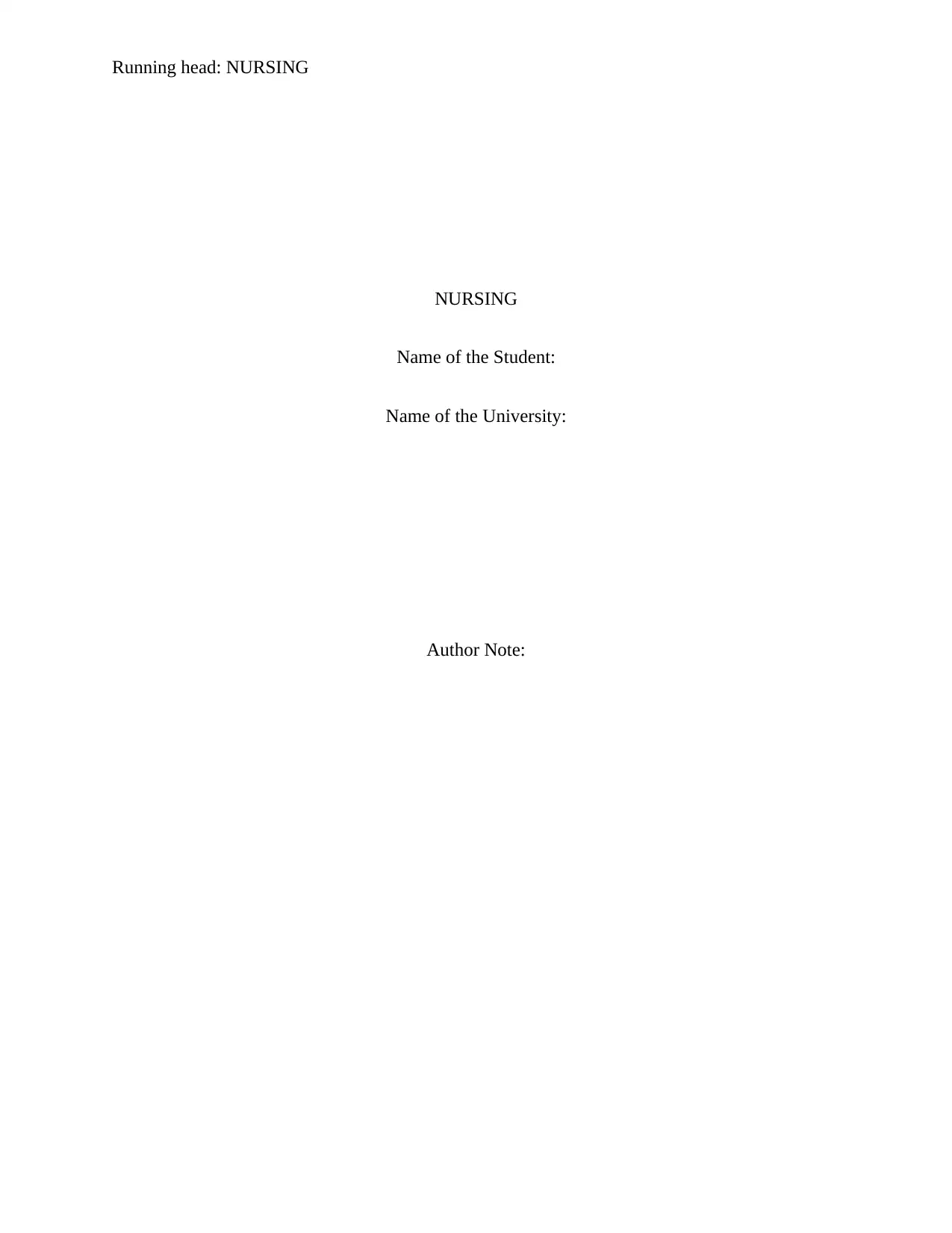
Running head: NURSING
NURSING
Name of the Student:
Name of the University:
Author Note:
NURSING
Name of the Student:
Name of the University:
Author Note:
Secure Best Marks with AI Grader
Need help grading? Try our AI Grader for instant feedback on your assignments.
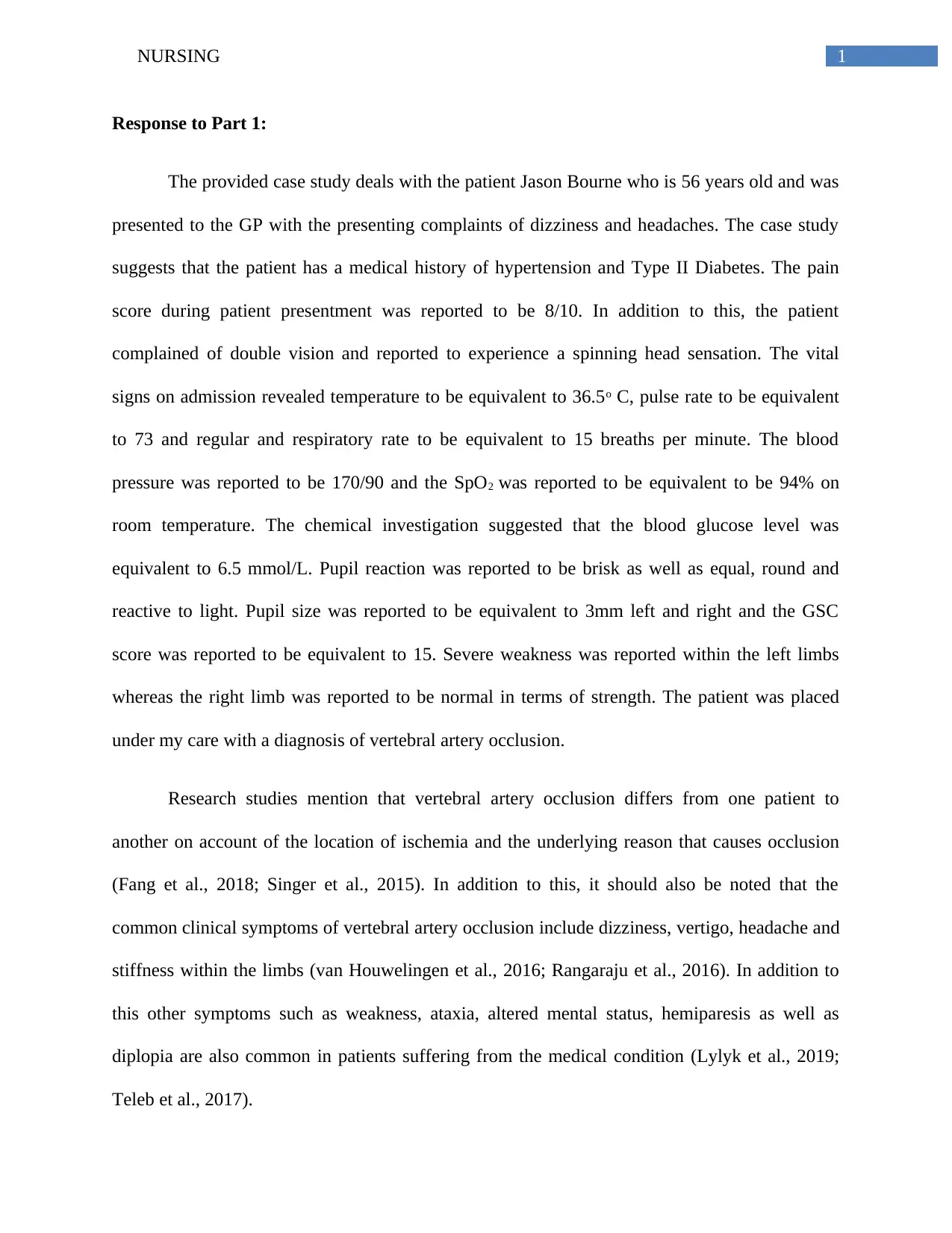
1NURSING
Response to Part 1:
The provided case study deals with the patient Jason Bourne who is 56 years old and was
presented to the GP with the presenting complaints of dizziness and headaches. The case study
suggests that the patient has a medical history of hypertension and Type II Diabetes. The pain
score during patient presentment was reported to be 8/10. In addition to this, the patient
complained of double vision and reported to experience a spinning head sensation. The vital
signs on admission revealed temperature to be equivalent to 36.5ᵒ C, pulse rate to be equivalent
to 73 and regular and respiratory rate to be equivalent to 15 breaths per minute. The blood
pressure was reported to be 170/90 and the SpO2 was reported to be equivalent to be 94% on
room temperature. The chemical investigation suggested that the blood glucose level was
equivalent to 6.5 mmol/L. Pupil reaction was reported to be brisk as well as equal, round and
reactive to light. Pupil size was reported to be equivalent to 3mm left and right and the GSC
score was reported to be equivalent to 15. Severe weakness was reported within the left limbs
whereas the right limb was reported to be normal in terms of strength. The patient was placed
under my care with a diagnosis of vertebral artery occlusion.
Research studies mention that vertebral artery occlusion differs from one patient to
another on account of the location of ischemia and the underlying reason that causes occlusion
(Fang et al., 2018; Singer et al., 2015). In addition to this, it should also be noted that the
common clinical symptoms of vertebral artery occlusion include dizziness, vertigo, headache and
stiffness within the limbs (van Houwelingen et al., 2016; Rangaraju et al., 2016). In addition to
this other symptoms such as weakness, ataxia, altered mental status, hemiparesis as well as
diplopia are also common in patients suffering from the medical condition (Lylyk et al., 2019;
Teleb et al., 2017).
Response to Part 1:
The provided case study deals with the patient Jason Bourne who is 56 years old and was
presented to the GP with the presenting complaints of dizziness and headaches. The case study
suggests that the patient has a medical history of hypertension and Type II Diabetes. The pain
score during patient presentment was reported to be 8/10. In addition to this, the patient
complained of double vision and reported to experience a spinning head sensation. The vital
signs on admission revealed temperature to be equivalent to 36.5ᵒ C, pulse rate to be equivalent
to 73 and regular and respiratory rate to be equivalent to 15 breaths per minute. The blood
pressure was reported to be 170/90 and the SpO2 was reported to be equivalent to be 94% on
room temperature. The chemical investigation suggested that the blood glucose level was
equivalent to 6.5 mmol/L. Pupil reaction was reported to be brisk as well as equal, round and
reactive to light. Pupil size was reported to be equivalent to 3mm left and right and the GSC
score was reported to be equivalent to 15. Severe weakness was reported within the left limbs
whereas the right limb was reported to be normal in terms of strength. The patient was placed
under my care with a diagnosis of vertebral artery occlusion.
Research studies mention that vertebral artery occlusion differs from one patient to
another on account of the location of ischemia and the underlying reason that causes occlusion
(Fang et al., 2018; Singer et al., 2015). In addition to this, it should also be noted that the
common clinical symptoms of vertebral artery occlusion include dizziness, vertigo, headache and
stiffness within the limbs (van Houwelingen et al., 2016; Rangaraju et al., 2016). In addition to
this other symptoms such as weakness, ataxia, altered mental status, hemiparesis as well as
diplopia are also common in patients suffering from the medical condition (Lylyk et al., 2019;
Teleb et al., 2017).
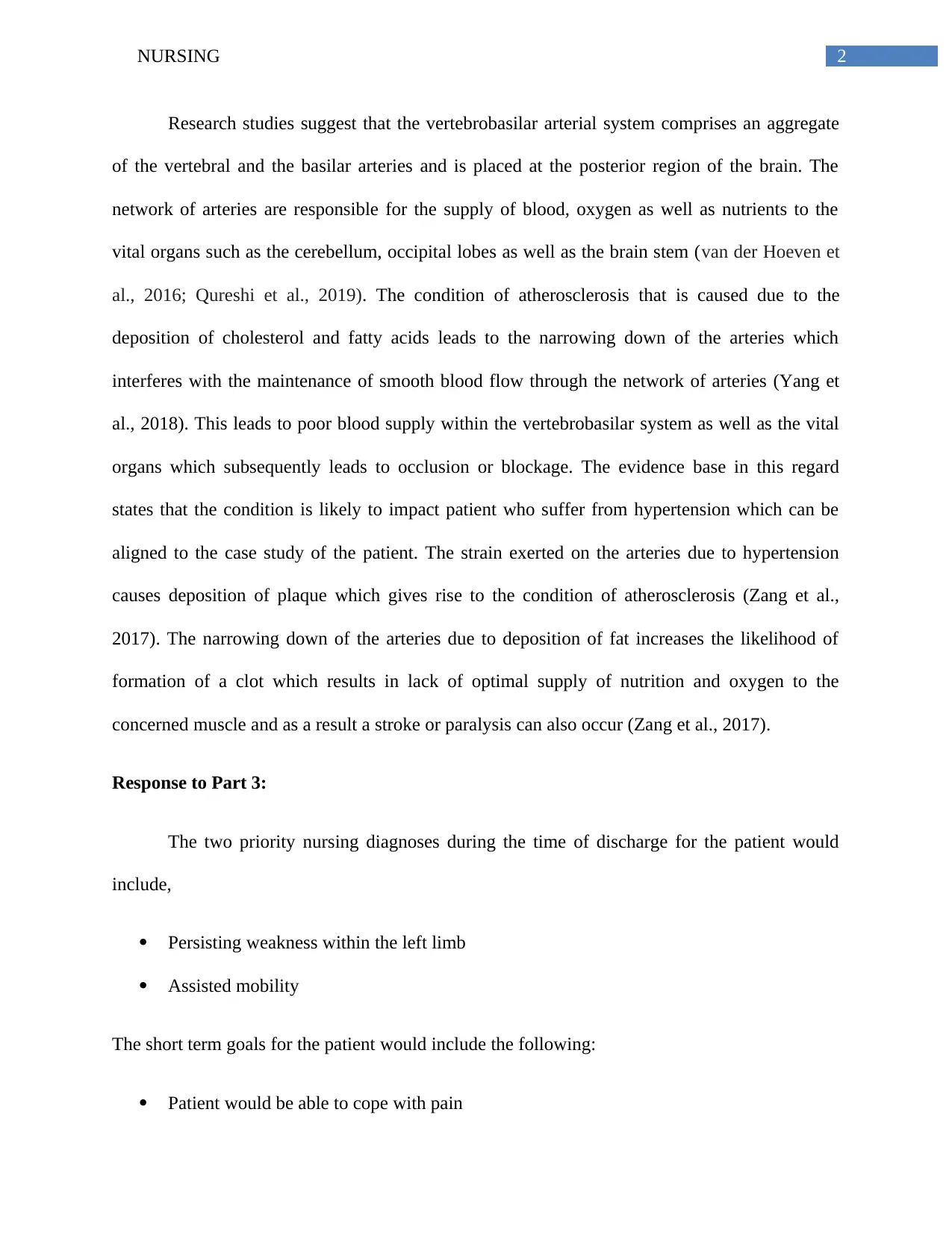
2NURSING
Research studies suggest that the vertebrobasilar arterial system comprises an aggregate
of the vertebral and the basilar arteries and is placed at the posterior region of the brain. The
network of arteries are responsible for the supply of blood, oxygen as well as nutrients to the
vital organs such as the cerebellum, occipital lobes as well as the brain stem (van der Hoeven et
al., 2016; Qureshi et al., 2019). The condition of atherosclerosis that is caused due to the
deposition of cholesterol and fatty acids leads to the narrowing down of the arteries which
interferes with the maintenance of smooth blood flow through the network of arteries (Yang et
al., 2018). This leads to poor blood supply within the vertebrobasilar system as well as the vital
organs which subsequently leads to occlusion or blockage. The evidence base in this regard
states that the condition is likely to impact patient who suffer from hypertension which can be
aligned to the case study of the patient. The strain exerted on the arteries due to hypertension
causes deposition of plaque which gives rise to the condition of atherosclerosis (Zang et al.,
2017). The narrowing down of the arteries due to deposition of fat increases the likelihood of
formation of a clot which results in lack of optimal supply of nutrition and oxygen to the
concerned muscle and as a result a stroke or paralysis can also occur (Zang et al., 2017).
Response to Part 3:
The two priority nursing diagnoses during the time of discharge for the patient would
include,
Persisting weakness within the left limb
Assisted mobility
The short term goals for the patient would include the following:
Patient would be able to cope with pain
Research studies suggest that the vertebrobasilar arterial system comprises an aggregate
of the vertebral and the basilar arteries and is placed at the posterior region of the brain. The
network of arteries are responsible for the supply of blood, oxygen as well as nutrients to the
vital organs such as the cerebellum, occipital lobes as well as the brain stem (van der Hoeven et
al., 2016; Qureshi et al., 2019). The condition of atherosclerosis that is caused due to the
deposition of cholesterol and fatty acids leads to the narrowing down of the arteries which
interferes with the maintenance of smooth blood flow through the network of arteries (Yang et
al., 2018). This leads to poor blood supply within the vertebrobasilar system as well as the vital
organs which subsequently leads to occlusion or blockage. The evidence base in this regard
states that the condition is likely to impact patient who suffer from hypertension which can be
aligned to the case study of the patient. The strain exerted on the arteries due to hypertension
causes deposition of plaque which gives rise to the condition of atherosclerosis (Zang et al.,
2017). The narrowing down of the arteries due to deposition of fat increases the likelihood of
formation of a clot which results in lack of optimal supply of nutrition and oxygen to the
concerned muscle and as a result a stroke or paralysis can also occur (Zang et al., 2017).
Response to Part 3:
The two priority nursing diagnoses during the time of discharge for the patient would
include,
Persisting weakness within the left limb
Assisted mobility
The short term goals for the patient would include the following:
Patient would be able to cope with pain
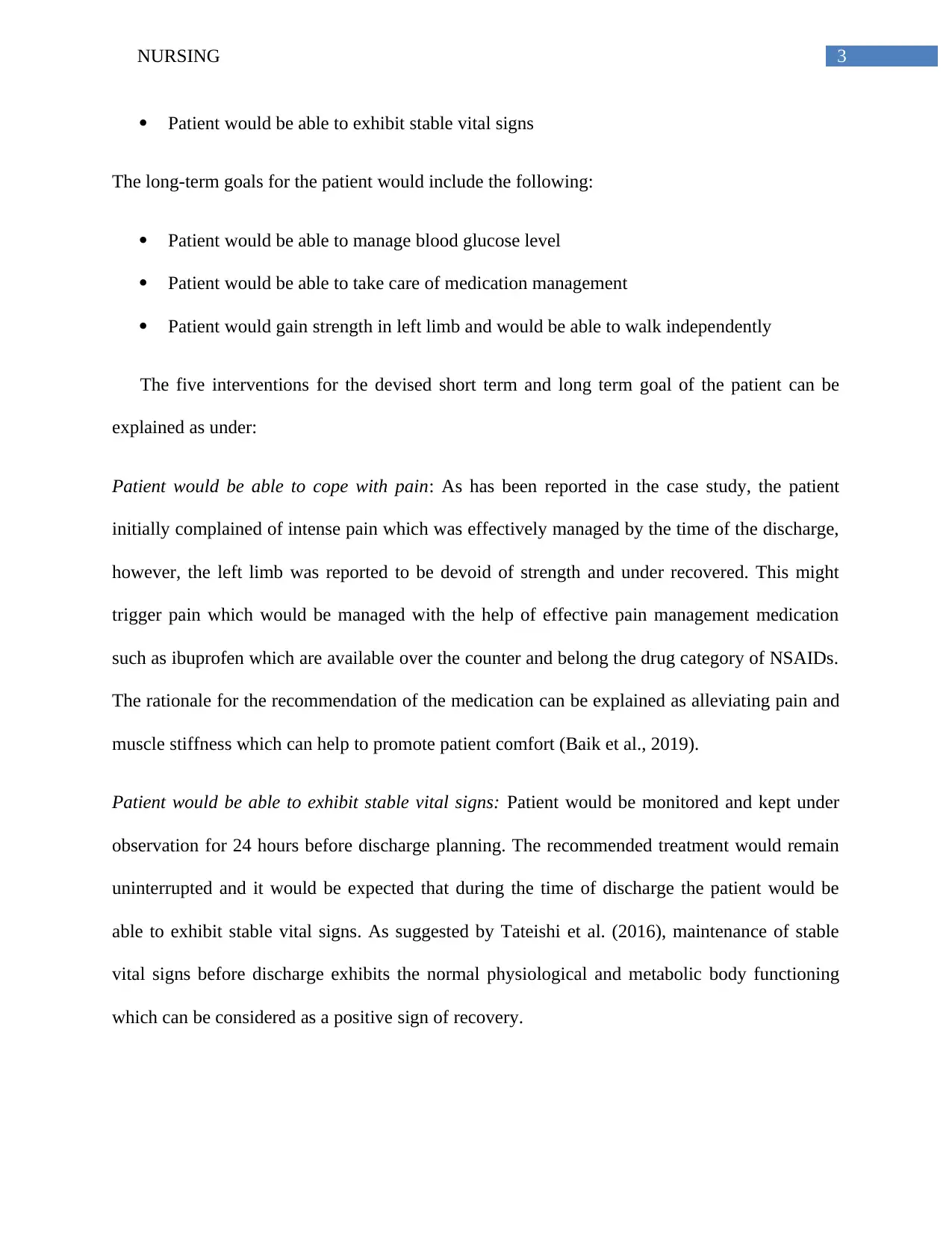
3NURSING
Patient would be able to exhibit stable vital signs
The long-term goals for the patient would include the following:
Patient would be able to manage blood glucose level
Patient would be able to take care of medication management
Patient would gain strength in left limb and would be able to walk independently
The five interventions for the devised short term and long term goal of the patient can be
explained as under:
Patient would be able to cope with pain: As has been reported in the case study, the patient
initially complained of intense pain which was effectively managed by the time of the discharge,
however, the left limb was reported to be devoid of strength and under recovered. This might
trigger pain which would be managed with the help of effective pain management medication
such as ibuprofen which are available over the counter and belong the drug category of NSAIDs.
The rationale for the recommendation of the medication can be explained as alleviating pain and
muscle stiffness which can help to promote patient comfort (Baik et al., 2019).
Patient would be able to exhibit stable vital signs: Patient would be monitored and kept under
observation for 24 hours before discharge planning. The recommended treatment would remain
uninterrupted and it would be expected that during the time of discharge the patient would be
able to exhibit stable vital signs. As suggested by Tateishi et al. (2016), maintenance of stable
vital signs before discharge exhibits the normal physiological and metabolic body functioning
which can be considered as a positive sign of recovery.
Patient would be able to exhibit stable vital signs
The long-term goals for the patient would include the following:
Patient would be able to manage blood glucose level
Patient would be able to take care of medication management
Patient would gain strength in left limb and would be able to walk independently
The five interventions for the devised short term and long term goal of the patient can be
explained as under:
Patient would be able to cope with pain: As has been reported in the case study, the patient
initially complained of intense pain which was effectively managed by the time of the discharge,
however, the left limb was reported to be devoid of strength and under recovered. This might
trigger pain which would be managed with the help of effective pain management medication
such as ibuprofen which are available over the counter and belong the drug category of NSAIDs.
The rationale for the recommendation of the medication can be explained as alleviating pain and
muscle stiffness which can help to promote patient comfort (Baik et al., 2019).
Patient would be able to exhibit stable vital signs: Patient would be monitored and kept under
observation for 24 hours before discharge planning. The recommended treatment would remain
uninterrupted and it would be expected that during the time of discharge the patient would be
able to exhibit stable vital signs. As suggested by Tateishi et al. (2016), maintenance of stable
vital signs before discharge exhibits the normal physiological and metabolic body functioning
which can be considered as a positive sign of recovery.
Secure Best Marks with AI Grader
Need help grading? Try our AI Grader for instant feedback on your assignments.
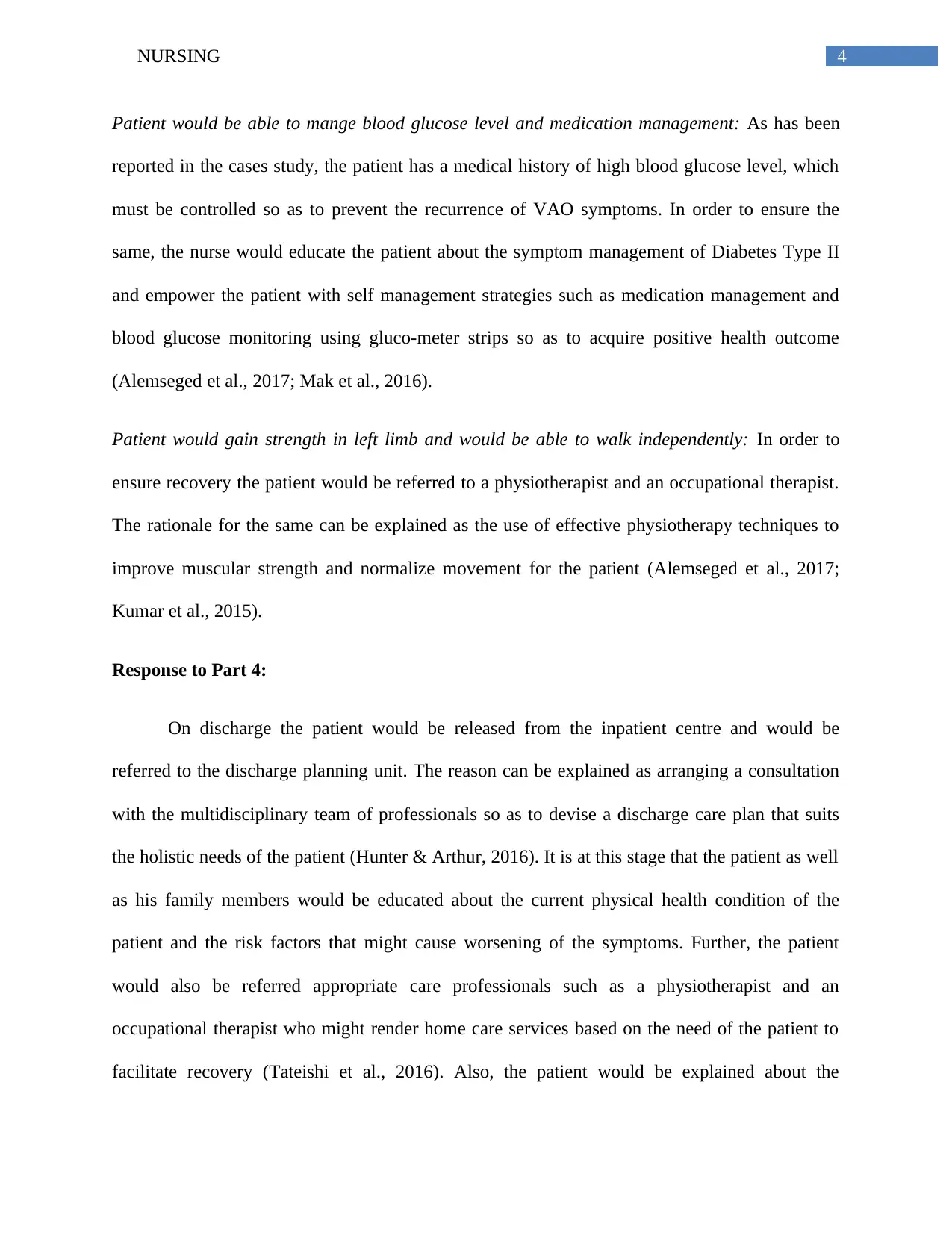
4NURSING
Patient would be able to mange blood glucose level and medication management: As has been
reported in the cases study, the patient has a medical history of high blood glucose level, which
must be controlled so as to prevent the recurrence of VAO symptoms. In order to ensure the
same, the nurse would educate the patient about the symptom management of Diabetes Type II
and empower the patient with self management strategies such as medication management and
blood glucose monitoring using gluco-meter strips so as to acquire positive health outcome
(Alemseged et al., 2017; Mak et al., 2016).
Patient would gain strength in left limb and would be able to walk independently: In order to
ensure recovery the patient would be referred to a physiotherapist and an occupational therapist.
The rationale for the same can be explained as the use of effective physiotherapy techniques to
improve muscular strength and normalize movement for the patient (Alemseged et al., 2017;
Kumar et al., 2015).
Response to Part 4:
On discharge the patient would be released from the inpatient centre and would be
referred to the discharge planning unit. The reason can be explained as arranging a consultation
with the multidisciplinary team of professionals so as to devise a discharge care plan that suits
the holistic needs of the patient (Hunter & Arthur, 2016). It is at this stage that the patient as well
as his family members would be educated about the current physical health condition of the
patient and the risk factors that might cause worsening of the symptoms. Further, the patient
would also be referred appropriate care professionals such as a physiotherapist and an
occupational therapist who might render home care services based on the need of the patient to
facilitate recovery (Tateishi et al., 2016). Also, the patient would be explained about the
Patient would be able to mange blood glucose level and medication management: As has been
reported in the cases study, the patient has a medical history of high blood glucose level, which
must be controlled so as to prevent the recurrence of VAO symptoms. In order to ensure the
same, the nurse would educate the patient about the symptom management of Diabetes Type II
and empower the patient with self management strategies such as medication management and
blood glucose monitoring using gluco-meter strips so as to acquire positive health outcome
(Alemseged et al., 2017; Mak et al., 2016).
Patient would gain strength in left limb and would be able to walk independently: In order to
ensure recovery the patient would be referred to a physiotherapist and an occupational therapist.
The rationale for the same can be explained as the use of effective physiotherapy techniques to
improve muscular strength and normalize movement for the patient (Alemseged et al., 2017;
Kumar et al., 2015).
Response to Part 4:
On discharge the patient would be released from the inpatient centre and would be
referred to the discharge planning unit. The reason can be explained as arranging a consultation
with the multidisciplinary team of professionals so as to devise a discharge care plan that suits
the holistic needs of the patient (Hunter & Arthur, 2016). It is at this stage that the patient as well
as his family members would be educated about the current physical health condition of the
patient and the risk factors that might cause worsening of the symptoms. Further, the patient
would also be referred appropriate care professionals such as a physiotherapist and an
occupational therapist who might render home care services based on the need of the patient to
facilitate recovery (Tateishi et al., 2016). Also, the patient would be explained about the
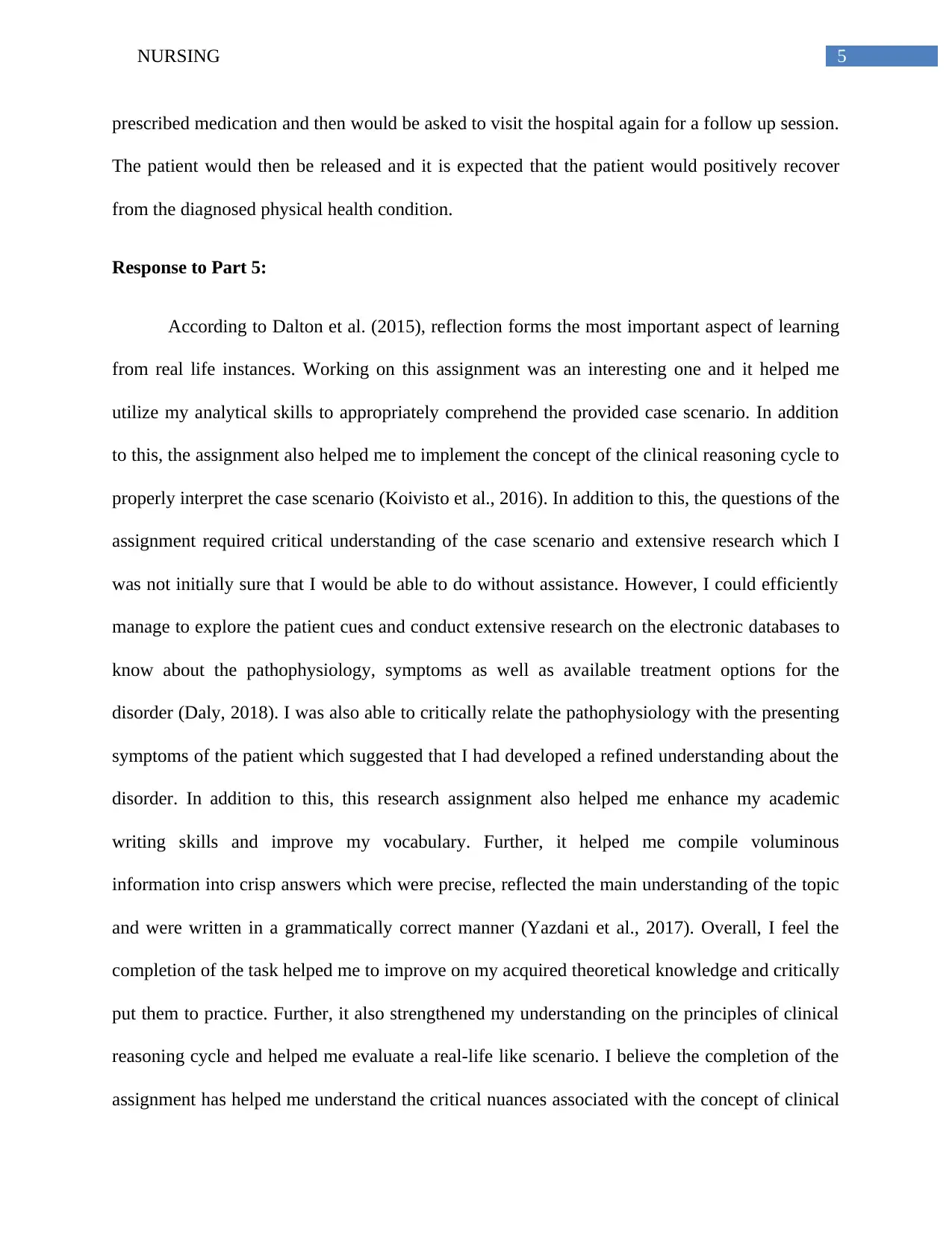
5NURSING
prescribed medication and then would be asked to visit the hospital again for a follow up session.
The patient would then be released and it is expected that the patient would positively recover
from the diagnosed physical health condition.
Response to Part 5:
According to Dalton et al. (2015), reflection forms the most important aspect of learning
from real life instances. Working on this assignment was an interesting one and it helped me
utilize my analytical skills to appropriately comprehend the provided case scenario. In addition
to this, the assignment also helped me to implement the concept of the clinical reasoning cycle to
properly interpret the case scenario (Koivisto et al., 2016). In addition to this, the questions of the
assignment required critical understanding of the case scenario and extensive research which I
was not initially sure that I would be able to do without assistance. However, I could efficiently
manage to explore the patient cues and conduct extensive research on the electronic databases to
know about the pathophysiology, symptoms as well as available treatment options for the
disorder (Daly, 2018). I was also able to critically relate the pathophysiology with the presenting
symptoms of the patient which suggested that I had developed a refined understanding about the
disorder. In addition to this, this research assignment also helped me enhance my academic
writing skills and improve my vocabulary. Further, it helped me compile voluminous
information into crisp answers which were precise, reflected the main understanding of the topic
and were written in a grammatically correct manner (Yazdani et al., 2017). Overall, I feel the
completion of the task helped me to improve on my acquired theoretical knowledge and critically
put them to practice. Further, it also strengthened my understanding on the principles of clinical
reasoning cycle and helped me evaluate a real-life like scenario. I believe the completion of the
assignment has helped me understand the critical nuances associated with the concept of clinical
prescribed medication and then would be asked to visit the hospital again for a follow up session.
The patient would then be released and it is expected that the patient would positively recover
from the diagnosed physical health condition.
Response to Part 5:
According to Dalton et al. (2015), reflection forms the most important aspect of learning
from real life instances. Working on this assignment was an interesting one and it helped me
utilize my analytical skills to appropriately comprehend the provided case scenario. In addition
to this, the assignment also helped me to implement the concept of the clinical reasoning cycle to
properly interpret the case scenario (Koivisto et al., 2016). In addition to this, the questions of the
assignment required critical understanding of the case scenario and extensive research which I
was not initially sure that I would be able to do without assistance. However, I could efficiently
manage to explore the patient cues and conduct extensive research on the electronic databases to
know about the pathophysiology, symptoms as well as available treatment options for the
disorder (Daly, 2018). I was also able to critically relate the pathophysiology with the presenting
symptoms of the patient which suggested that I had developed a refined understanding about the
disorder. In addition to this, this research assignment also helped me enhance my academic
writing skills and improve my vocabulary. Further, it helped me compile voluminous
information into crisp answers which were precise, reflected the main understanding of the topic
and were written in a grammatically correct manner (Yazdani et al., 2017). Overall, I feel the
completion of the task helped me to improve on my acquired theoretical knowledge and critically
put them to practice. Further, it also strengthened my understanding on the principles of clinical
reasoning cycle and helped me evaluate a real-life like scenario. I believe the completion of the
assignment has helped me understand the critical nuances associated with the concept of clinical
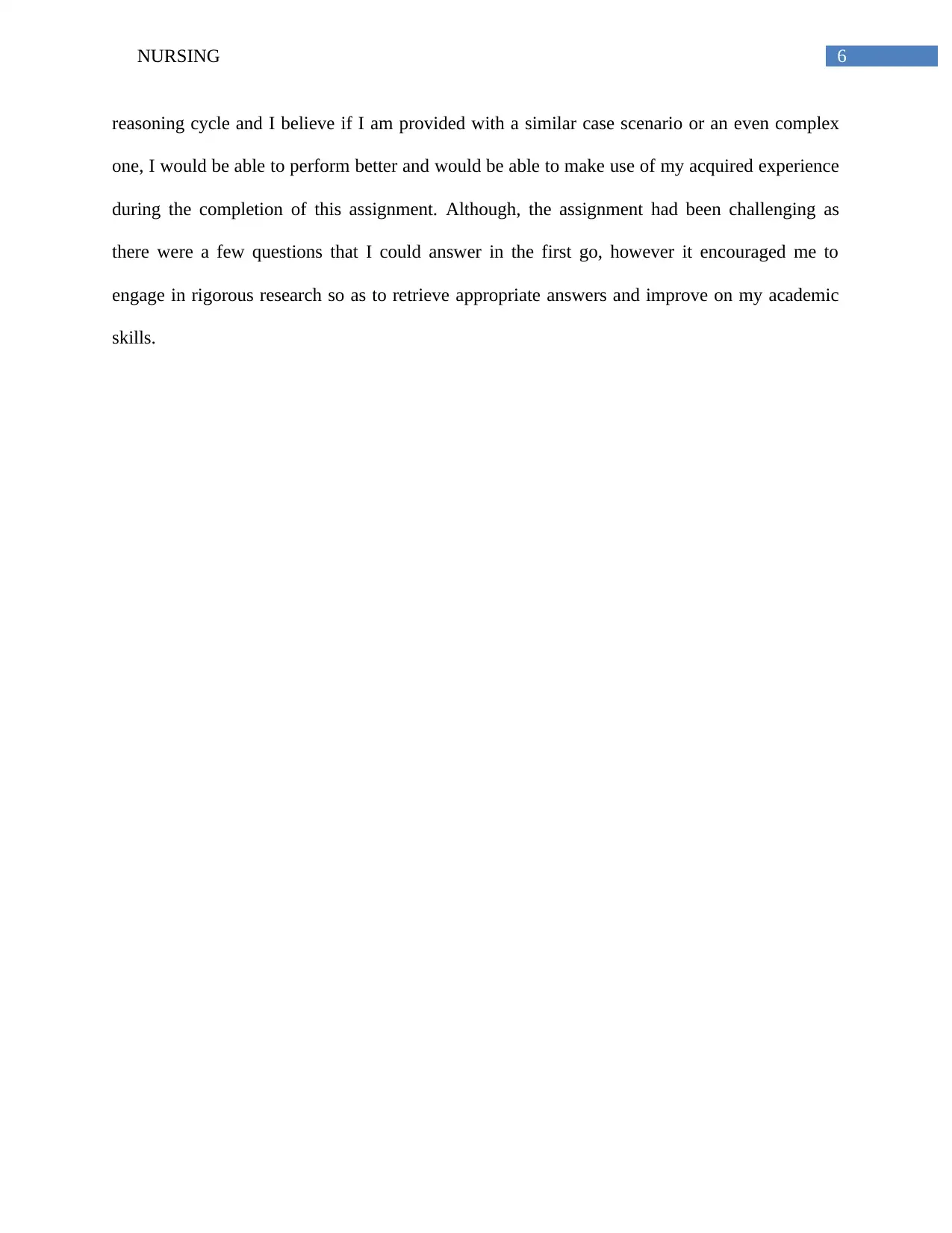
6NURSING
reasoning cycle and I believe if I am provided with a similar case scenario or an even complex
one, I would be able to perform better and would be able to make use of my acquired experience
during the completion of this assignment. Although, the assignment had been challenging as
there were a few questions that I could answer in the first go, however it encouraged me to
engage in rigorous research so as to retrieve appropriate answers and improve on my academic
skills.
reasoning cycle and I believe if I am provided with a similar case scenario or an even complex
one, I would be able to perform better and would be able to make use of my acquired experience
during the completion of this assignment. Although, the assignment had been challenging as
there were a few questions that I could answer in the first go, however it encouraged me to
engage in rigorous research so as to retrieve appropriate answers and improve on my academic
skills.
Paraphrase This Document
Need a fresh take? Get an instant paraphrase of this document with our AI Paraphraser
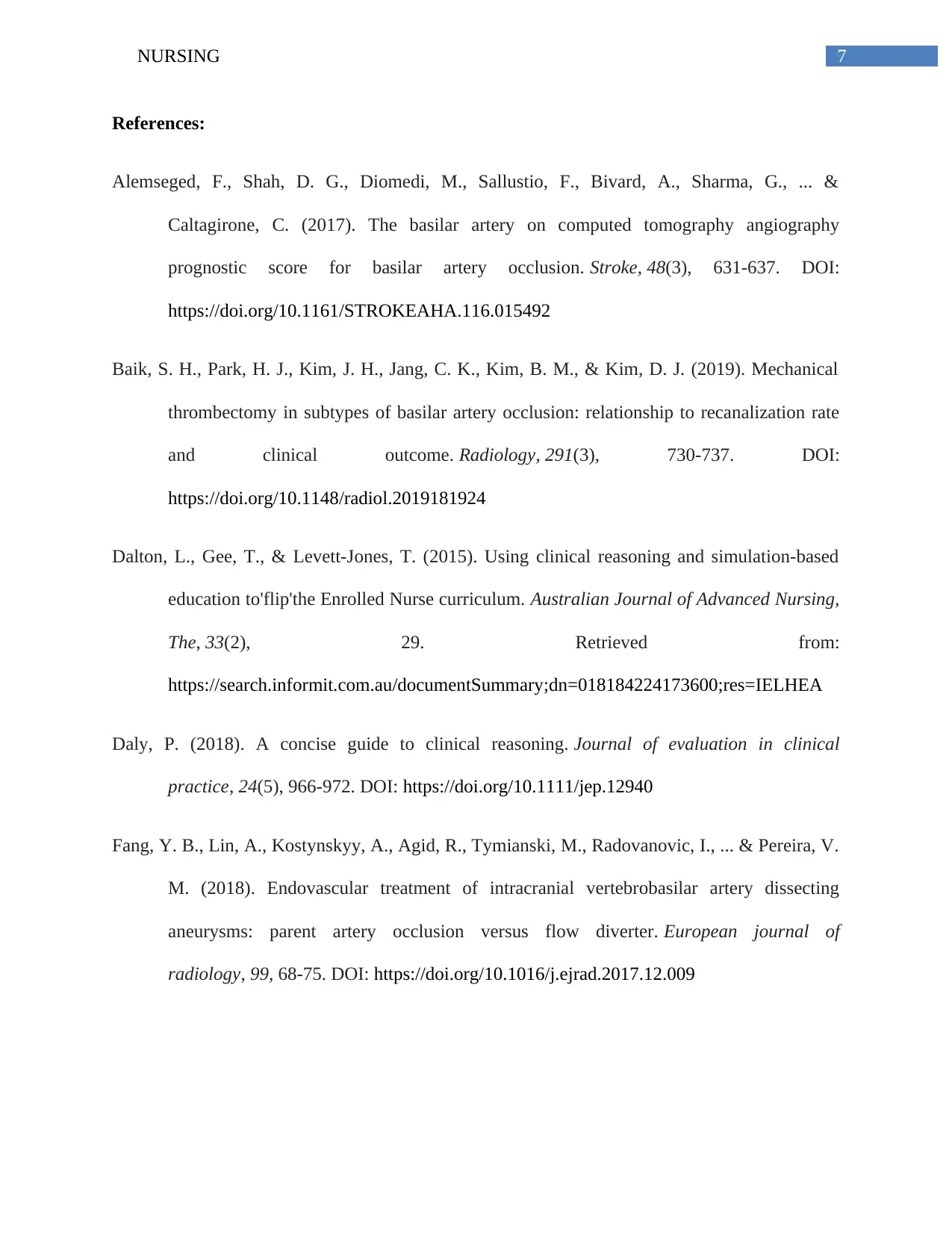
7NURSING
References:
Alemseged, F., Shah, D. G., Diomedi, M., Sallustio, F., Bivard, A., Sharma, G., ... &
Caltagirone, C. (2017). The basilar artery on computed tomography angiography
prognostic score for basilar artery occlusion. Stroke, 48(3), 631-637. DOI:
https://doi.org/10.1161/STROKEAHA.116.015492
Baik, S. H., Park, H. J., Kim, J. H., Jang, C. K., Kim, B. M., & Kim, D. J. (2019). Mechanical
thrombectomy in subtypes of basilar artery occlusion: relationship to recanalization rate
and clinical outcome. Radiology, 291(3), 730-737. DOI:
https://doi.org/10.1148/radiol.2019181924
Dalton, L., Gee, T., & Levett-Jones, T. (2015). Using clinical reasoning and simulation-based
education to'flip'the Enrolled Nurse curriculum. Australian Journal of Advanced Nursing,
The, 33(2), 29. Retrieved from:
https://search.informit.com.au/documentSummary;dn=018184224173600;res=IELHEA
Daly, P. (2018). A concise guide to clinical reasoning. Journal of evaluation in clinical
practice, 24(5), 966-972. DOI: https://doi.org/10.1111/jep.12940
Fang, Y. B., Lin, A., Kostynskyy, A., Agid, R., Tymianski, M., Radovanovic, I., ... & Pereira, V.
M. (2018). Endovascular treatment of intracranial vertebrobasilar artery dissecting
aneurysms: parent artery occlusion versus flow diverter. European journal of
radiology, 99, 68-75. DOI: https://doi.org/10.1016/j.ejrad.2017.12.009
References:
Alemseged, F., Shah, D. G., Diomedi, M., Sallustio, F., Bivard, A., Sharma, G., ... &
Caltagirone, C. (2017). The basilar artery on computed tomography angiography
prognostic score for basilar artery occlusion. Stroke, 48(3), 631-637. DOI:
https://doi.org/10.1161/STROKEAHA.116.015492
Baik, S. H., Park, H. J., Kim, J. H., Jang, C. K., Kim, B. M., & Kim, D. J. (2019). Mechanical
thrombectomy in subtypes of basilar artery occlusion: relationship to recanalization rate
and clinical outcome. Radiology, 291(3), 730-737. DOI:
https://doi.org/10.1148/radiol.2019181924
Dalton, L., Gee, T., & Levett-Jones, T. (2015). Using clinical reasoning and simulation-based
education to'flip'the Enrolled Nurse curriculum. Australian Journal of Advanced Nursing,
The, 33(2), 29. Retrieved from:
https://search.informit.com.au/documentSummary;dn=018184224173600;res=IELHEA
Daly, P. (2018). A concise guide to clinical reasoning. Journal of evaluation in clinical
practice, 24(5), 966-972. DOI: https://doi.org/10.1111/jep.12940
Fang, Y. B., Lin, A., Kostynskyy, A., Agid, R., Tymianski, M., Radovanovic, I., ... & Pereira, V.
M. (2018). Endovascular treatment of intracranial vertebrobasilar artery dissecting
aneurysms: parent artery occlusion versus flow diverter. European journal of
radiology, 99, 68-75. DOI: https://doi.org/10.1016/j.ejrad.2017.12.009
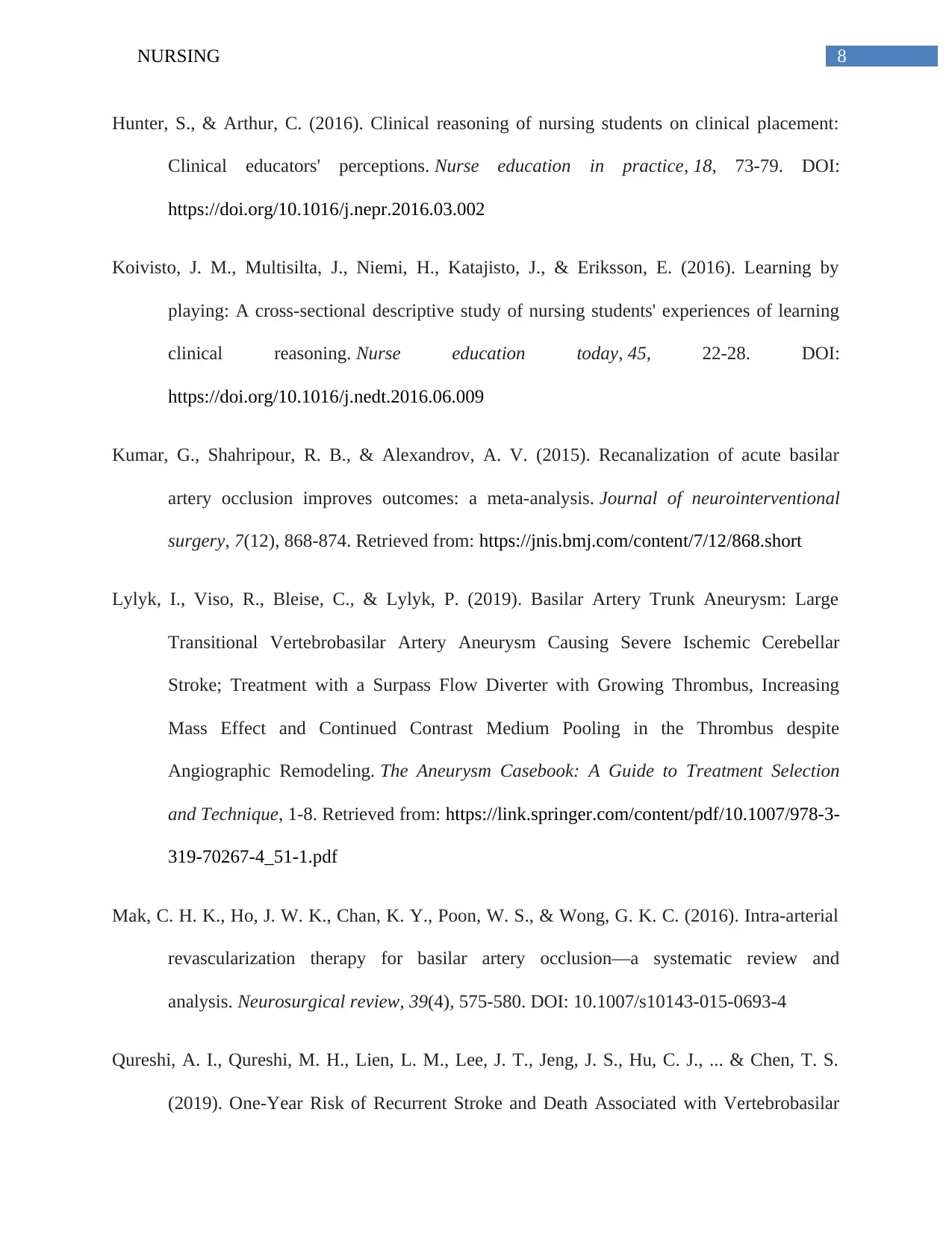
8NURSING
Hunter, S., & Arthur, C. (2016). Clinical reasoning of nursing students on clinical placement:
Clinical educators' perceptions. Nurse education in practice, 18, 73-79. DOI:
https://doi.org/10.1016/j.nepr.2016.03.002
Koivisto, J. M., Multisilta, J., Niemi, H., Katajisto, J., & Eriksson, E. (2016). Learning by
playing: A cross-sectional descriptive study of nursing students' experiences of learning
clinical reasoning. Nurse education today, 45, 22-28. DOI:
https://doi.org/10.1016/j.nedt.2016.06.009
Kumar, G., Shahripour, R. B., & Alexandrov, A. V. (2015). Recanalization of acute basilar
artery occlusion improves outcomes: a meta-analysis. Journal of neurointerventional
surgery, 7(12), 868-874. Retrieved from: https://jnis.bmj.com/content/7/12/868.short
Lylyk, I., Viso, R., Bleise, C., & Lylyk, P. (2019). Basilar Artery Trunk Aneurysm: Large
Transitional Vertebrobasilar Artery Aneurysm Causing Severe Ischemic Cerebellar
Stroke; Treatment with a Surpass Flow Diverter with Growing Thrombus, Increasing
Mass Effect and Continued Contrast Medium Pooling in the Thrombus despite
Angiographic Remodeling. The Aneurysm Casebook: A Guide to Treatment Selection
and Technique, 1-8. Retrieved from: https://link.springer.com/content/pdf/10.1007/978-3-
319-70267-4_51-1.pdf
Mak, C. H. K., Ho, J. W. K., Chan, K. Y., Poon, W. S., & Wong, G. K. C. (2016). Intra-arterial
revascularization therapy for basilar artery occlusion—a systematic review and
analysis. Neurosurgical review, 39(4), 575-580. DOI: 10.1007/s10143-015-0693-4
Qureshi, A. I., Qureshi, M. H., Lien, L. M., Lee, J. T., Jeng, J. S., Hu, C. J., ... & Chen, T. S.
(2019). One-Year Risk of Recurrent Stroke and Death Associated with Vertebrobasilar
Hunter, S., & Arthur, C. (2016). Clinical reasoning of nursing students on clinical placement:
Clinical educators' perceptions. Nurse education in practice, 18, 73-79. DOI:
https://doi.org/10.1016/j.nepr.2016.03.002
Koivisto, J. M., Multisilta, J., Niemi, H., Katajisto, J., & Eriksson, E. (2016). Learning by
playing: A cross-sectional descriptive study of nursing students' experiences of learning
clinical reasoning. Nurse education today, 45, 22-28. DOI:
https://doi.org/10.1016/j.nedt.2016.06.009
Kumar, G., Shahripour, R. B., & Alexandrov, A. V. (2015). Recanalization of acute basilar
artery occlusion improves outcomes: a meta-analysis. Journal of neurointerventional
surgery, 7(12), 868-874. Retrieved from: https://jnis.bmj.com/content/7/12/868.short
Lylyk, I., Viso, R., Bleise, C., & Lylyk, P. (2019). Basilar Artery Trunk Aneurysm: Large
Transitional Vertebrobasilar Artery Aneurysm Causing Severe Ischemic Cerebellar
Stroke; Treatment with a Surpass Flow Diverter with Growing Thrombus, Increasing
Mass Effect and Continued Contrast Medium Pooling in the Thrombus despite
Angiographic Remodeling. The Aneurysm Casebook: A Guide to Treatment Selection
and Technique, 1-8. Retrieved from: https://link.springer.com/content/pdf/10.1007/978-3-
319-70267-4_51-1.pdf
Mak, C. H. K., Ho, J. W. K., Chan, K. Y., Poon, W. S., & Wong, G. K. C. (2016). Intra-arterial
revascularization therapy for basilar artery occlusion—a systematic review and
analysis. Neurosurgical review, 39(4), 575-580. DOI: 10.1007/s10143-015-0693-4
Qureshi, A. I., Qureshi, M. H., Lien, L. M., Lee, J. T., Jeng, J. S., Hu, C. J., ... & Chen, T. S.
(2019). One-Year Risk of Recurrent Stroke and Death Associated with Vertebrobasilar
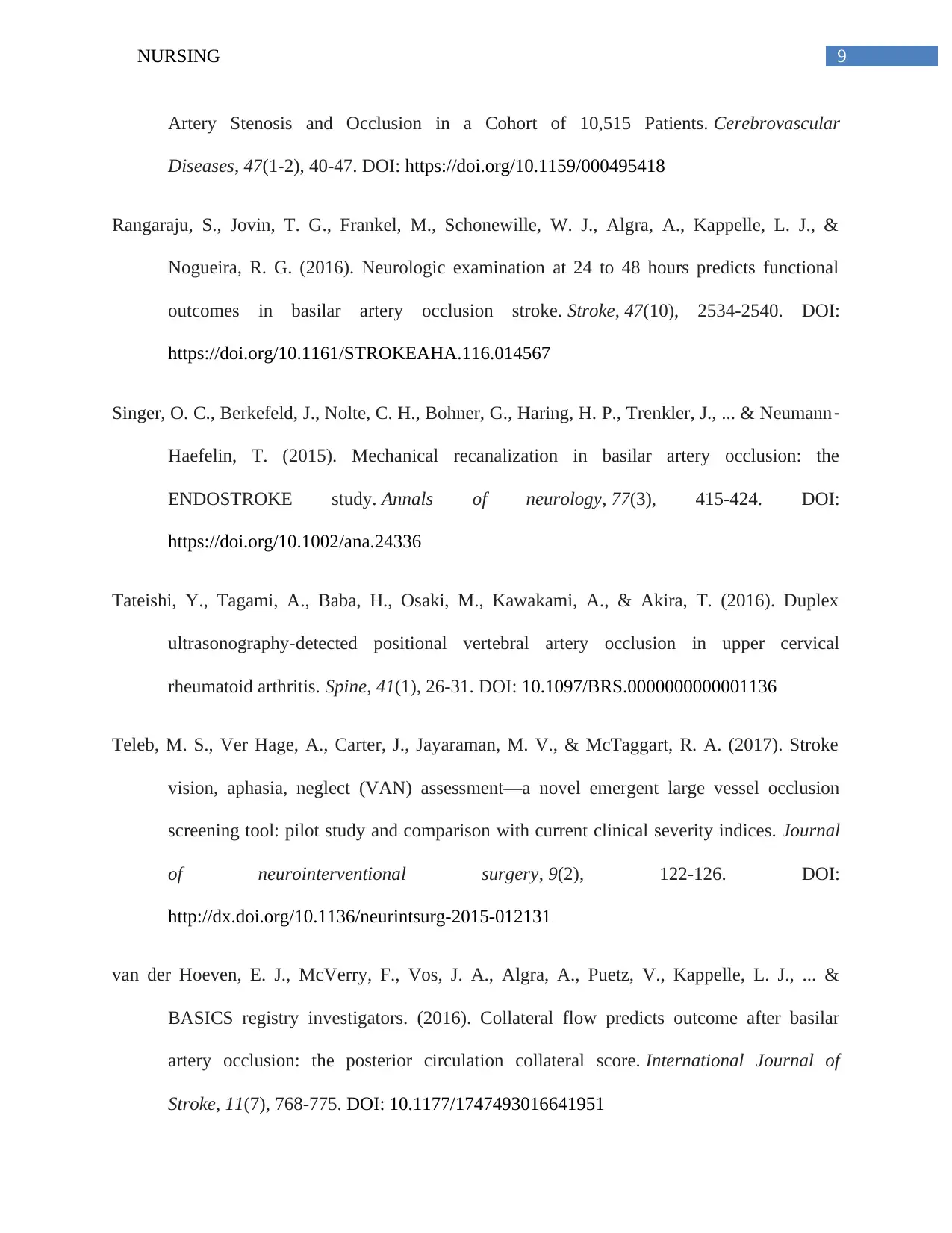
9NURSING
Artery Stenosis and Occlusion in a Cohort of 10,515 Patients. Cerebrovascular
Diseases, 47(1-2), 40-47. DOI: https://doi.org/10.1159/000495418
Rangaraju, S., Jovin, T. G., Frankel, M., Schonewille, W. J., Algra, A., Kappelle, L. J., &
Nogueira, R. G. (2016). Neurologic examination at 24 to 48 hours predicts functional
outcomes in basilar artery occlusion stroke. Stroke, 47(10), 2534-2540. DOI:
https://doi.org/10.1161/STROKEAHA.116.014567
Singer, O. C., Berkefeld, J., Nolte, C. H., Bohner, G., Haring, H. P., Trenkler, J., ... & Neumann‐
Haefelin, T. (2015). Mechanical recanalization in basilar artery occlusion: the
ENDOSTROKE study. Annals of neurology, 77(3), 415-424. DOI:
https://doi.org/10.1002/ana.24336
Tateishi, Y., Tagami, A., Baba, H., Osaki, M., Kawakami, A., & Akira, T. (2016). Duplex
ultrasonography-detected positional vertebral artery occlusion in upper cervical
rheumatoid arthritis. Spine, 41(1), 26-31. DOI: 10.1097/BRS.0000000000001136
Teleb, M. S., Ver Hage, A., Carter, J., Jayaraman, M. V., & McTaggart, R. A. (2017). Stroke
vision, aphasia, neglect (VAN) assessment—a novel emergent large vessel occlusion
screening tool: pilot study and comparison with current clinical severity indices. Journal
of neurointerventional surgery, 9(2), 122-126. DOI:
http://dx.doi.org/10.1136/neurintsurg-2015-012131
van der Hoeven, E. J., McVerry, F., Vos, J. A., Algra, A., Puetz, V., Kappelle, L. J., ... &
BASICS registry investigators. (2016). Collateral flow predicts outcome after basilar
artery occlusion: the posterior circulation collateral score. International Journal of
Stroke, 11(7), 768-775. DOI: 10.1177/1747493016641951
Artery Stenosis and Occlusion in a Cohort of 10,515 Patients. Cerebrovascular
Diseases, 47(1-2), 40-47. DOI: https://doi.org/10.1159/000495418
Rangaraju, S., Jovin, T. G., Frankel, M., Schonewille, W. J., Algra, A., Kappelle, L. J., &
Nogueira, R. G. (2016). Neurologic examination at 24 to 48 hours predicts functional
outcomes in basilar artery occlusion stroke. Stroke, 47(10), 2534-2540. DOI:
https://doi.org/10.1161/STROKEAHA.116.014567
Singer, O. C., Berkefeld, J., Nolte, C. H., Bohner, G., Haring, H. P., Trenkler, J., ... & Neumann‐
Haefelin, T. (2015). Mechanical recanalization in basilar artery occlusion: the
ENDOSTROKE study. Annals of neurology, 77(3), 415-424. DOI:
https://doi.org/10.1002/ana.24336
Tateishi, Y., Tagami, A., Baba, H., Osaki, M., Kawakami, A., & Akira, T. (2016). Duplex
ultrasonography-detected positional vertebral artery occlusion in upper cervical
rheumatoid arthritis. Spine, 41(1), 26-31. DOI: 10.1097/BRS.0000000000001136
Teleb, M. S., Ver Hage, A., Carter, J., Jayaraman, M. V., & McTaggart, R. A. (2017). Stroke
vision, aphasia, neglect (VAN) assessment—a novel emergent large vessel occlusion
screening tool: pilot study and comparison with current clinical severity indices. Journal
of neurointerventional surgery, 9(2), 122-126. DOI:
http://dx.doi.org/10.1136/neurintsurg-2015-012131
van der Hoeven, E. J., McVerry, F., Vos, J. A., Algra, A., Puetz, V., Kappelle, L. J., ... &
BASICS registry investigators. (2016). Collateral flow predicts outcome after basilar
artery occlusion: the posterior circulation collateral score. International Journal of
Stroke, 11(7), 768-775. DOI: 10.1177/1747493016641951
Secure Best Marks with AI Grader
Need help grading? Try our AI Grader for instant feedback on your assignments.
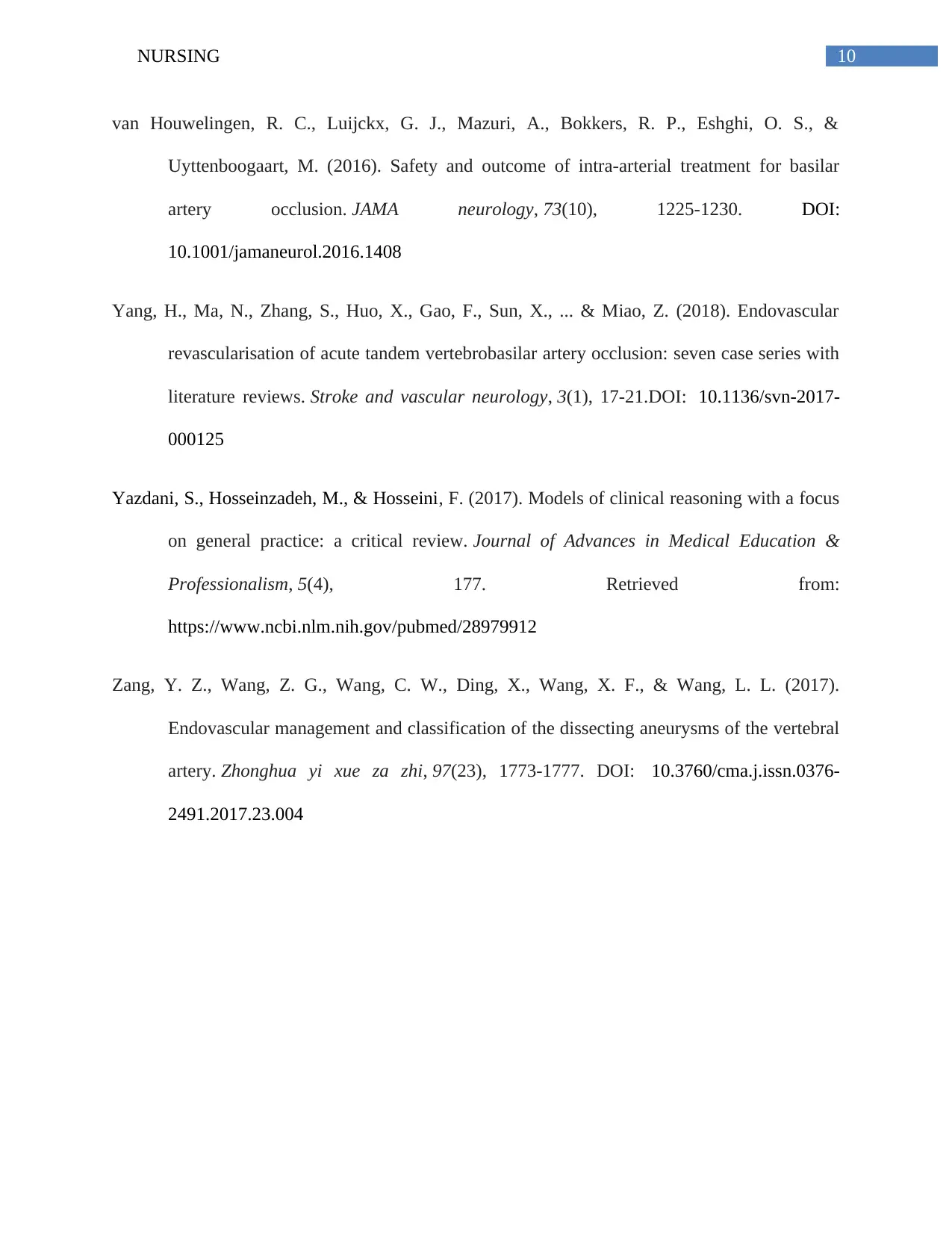
10NURSING
van Houwelingen, R. C., Luijckx, G. J., Mazuri, A., Bokkers, R. P., Eshghi, O. S., &
Uyttenboogaart, M. (2016). Safety and outcome of intra-arterial treatment for basilar
artery occlusion. JAMA neurology, 73(10), 1225-1230. DOI:
10.1001/jamaneurol.2016.1408
Yang, H., Ma, N., Zhang, S., Huo, X., Gao, F., Sun, X., ... & Miao, Z. (2018). Endovascular
revascularisation of acute tandem vertebrobasilar artery occlusion: seven case series with
literature reviews. Stroke and vascular neurology, 3(1), 17-21.DOI: 10.1136/svn-2017-
000125
Yazdani, S., Hosseinzadeh, M., & Hosseini, F. (2017). Models of clinical reasoning with a focus
on general practice: a critical review. Journal of Advances in Medical Education &
Professionalism, 5(4), 177. Retrieved from:
https://www.ncbi.nlm.nih.gov/pubmed/28979912
Zang, Y. Z., Wang, Z. G., Wang, C. W., Ding, X., Wang, X. F., & Wang, L. L. (2017).
Endovascular management and classification of the dissecting aneurysms of the vertebral
artery. Zhonghua yi xue za zhi, 97(23), 1773-1777. DOI: 10.3760/cma.j.issn.0376-
2491.2017.23.004
van Houwelingen, R. C., Luijckx, G. J., Mazuri, A., Bokkers, R. P., Eshghi, O. S., &
Uyttenboogaart, M. (2016). Safety and outcome of intra-arterial treatment for basilar
artery occlusion. JAMA neurology, 73(10), 1225-1230. DOI:
10.1001/jamaneurol.2016.1408
Yang, H., Ma, N., Zhang, S., Huo, X., Gao, F., Sun, X., ... & Miao, Z. (2018). Endovascular
revascularisation of acute tandem vertebrobasilar artery occlusion: seven case series with
literature reviews. Stroke and vascular neurology, 3(1), 17-21.DOI: 10.1136/svn-2017-
000125
Yazdani, S., Hosseinzadeh, M., & Hosseini, F. (2017). Models of clinical reasoning with a focus
on general practice: a critical review. Journal of Advances in Medical Education &
Professionalism, 5(4), 177. Retrieved from:
https://www.ncbi.nlm.nih.gov/pubmed/28979912
Zang, Y. Z., Wang, Z. G., Wang, C. W., Ding, X., Wang, X. F., & Wang, L. L. (2017).
Endovascular management and classification of the dissecting aneurysms of the vertebral
artery. Zhonghua yi xue za zhi, 97(23), 1773-1777. DOI: 10.3760/cma.j.issn.0376-
2491.2017.23.004
1 out of 11
Related Documents
Your All-in-One AI-Powered Toolkit for Academic Success.
+13062052269
info@desklib.com
Available 24*7 on WhatsApp / Email
![[object Object]](/_next/static/media/star-bottom.7253800d.svg)
Unlock your academic potential
© 2024 | Zucol Services PVT LTD | All rights reserved.





